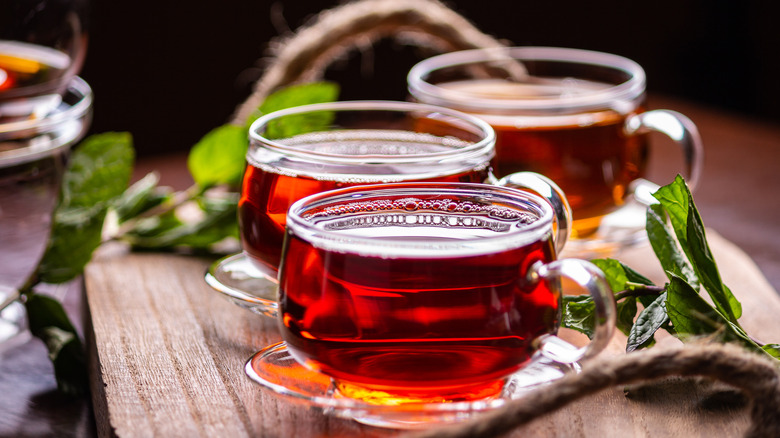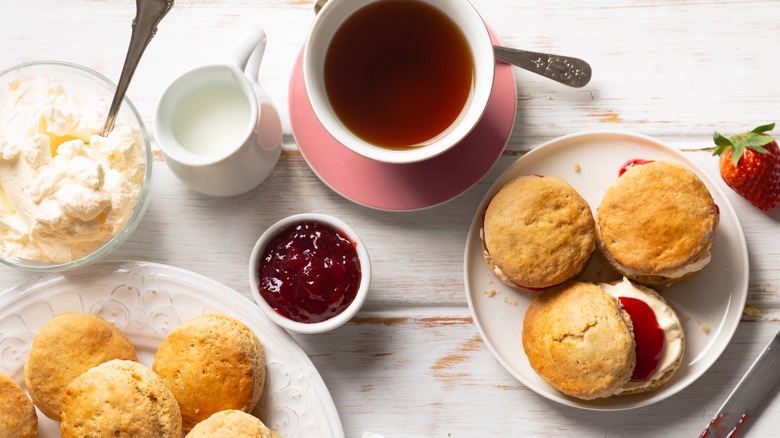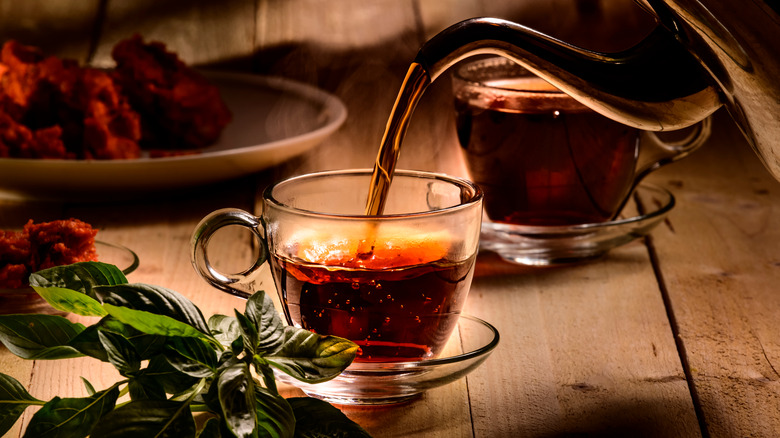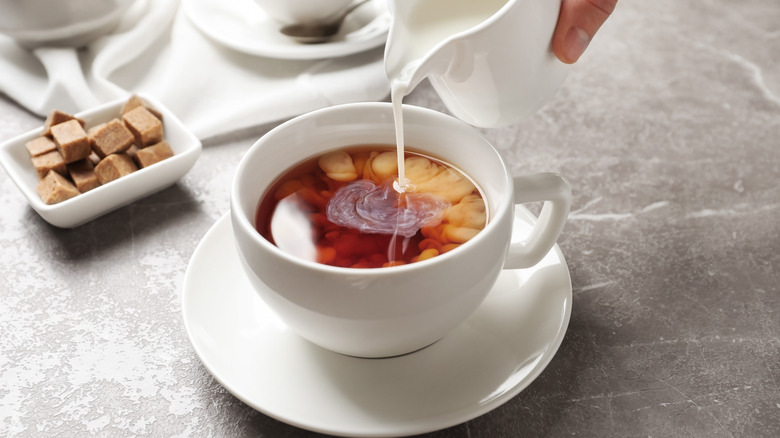The Differences Between The 3 Types Of UK Breakfast Teas
Tea is one of the world's most popular drinks. According to the World Green Tea Association, more than 3 million tons of tea are consumed around the globe every year. In the United States, more than half the population enjoys a cup or glass of tea on a daily basis, per the Tea Association of the United States. That's nothing compared to Britain, though, where the U.K. Tea & Infusions Association reports that 84% of people have a cup of tea every day (via BBC).
According to the BBC, Portuguese princess Catherine of Braganza was supposedly the first to popularize tea in Britain. Catherine first requested the drink when she arrived to marry King Charles II in 1662. As a part of their marriage, Portugal — where tea was already popular among aristocrats — gifted the monarchs with a chest of tea among other fine goods. The drink spread at court, and Britain Express says by the end of the century it was popular among the lower classes in British coffee houses as well.
According to Afternoon Tea Reads, later in the 1700s, Queen Anne would become known for popularizing the practice of drinking tea at breakfast, and today three main types of breakfast teas exist. Each is a distinct blend of black teas representing the variety of cultures and tastes in England, Ireland, and Scotland. All are made with black tea, and all can be enjoyed at breakfast, but each has subtle differences in taste and strength.
English Breakfast
English Breakfast tea is often described as being full-bodied and robust. According to The Tea Cup of Life, it is known to be the lightest in both flavor and in caffeine among the three U.K. breakfast blends. While it is full of bold flavors, it is never meant to taste bitter, per Afternoon Tea Reads. That doesn't mean that you won't need some milk, sugar, or something special to suit your tastes, though.
Frank Sanchez of Upton Tea Imports told The Kitchn that originally, this would have been a blend made entirely with Chinese tea leaves. For much of the 18th century, this would have been a traditional Chinese congou tea. As tensions with China worsened, however, and tea plantations in other regions took off, it became a much different blend.
The Tea Cup of Life describes the flavor as "bright and brisk." While blends often differ between manufacturers, English Breakfast is usually a mixture of Ceylon and Assam tea, with the occasional Keemun appearing in the ingredients list as well.
Irish Breakfast
Irish Breakfast tea is the next weight class up in terms of these three teas. Brewed Leaf Love says that it's also the most distinctive. Because Irish Breakfast primarily uses Assam tea leaves, it has a strong malty flavor and deep red color. According to Simple Loose Leaf, Assam is a type of tea that is primarily sourced from India. The Assam region produces approximately 50% of the tea in India, and its soil gives the leaves their unique terroir.
Twinings says that its Irish Breakfast blend also gets its red color from leaves that are grown in Kenya, and uses Indonesian and Chinese tea leaves to add a subtle smoothness as well. Farmer's Almanac notes that the Irish also like to take their tea strong and with lots of milk. Tea Cup of Life suggests that this may be because of the country's thriving dairy industry as well as to protect delicate tea cups.
Scottish Breakfast
The Scottish Breakfast blend is known by many to be the strongest of these three teas. According to Tea Cup of Life, Scottish Breakfast keeps some of the malted notes of Irish Breakfast but incorporates oaky flavors as well. It's typically a blend of Assam and Ceylon teas as well as leaves grown in Indonesia and China.
Frank Sanchez told The Kitchn that tea blends were originally designed to match the qualities of the local water. Since Scotland has softer water, it is believed that they crafted a stronger cup of tea to counteract it when brewing. Brewed Leaf Love says the strong flavor of the tea was meant to help cover up the taste of the poor-quality water. This is supposedly the least popular of these three breakfast blends as well.
If you're someone who would normally drink coffee in the morning and are trying to switch to tea, Scottish Breakfast might be the best blend for you. Its strong flavors go well with a nice hearty breakfast and a splash of milk.



